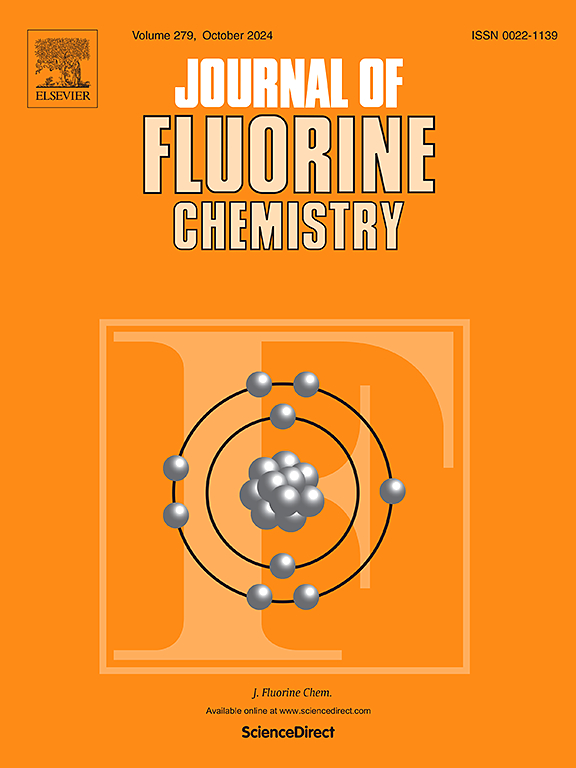2-羟基苯乙酮合成氟化4h -铬-4-酮及其抗癌和抗病毒活性的体外评价
IF 1.9
4区 化学
Q3 CHEMISTRY, INORGANIC & NUCLEAR
引用次数: 0
摘要
本文报道了合成大量苯环氟化的2-X取代的4h -4- 1衍生物(X = Me, CF3, SH, COOMe, COOEt)的简单而有用的方法。首先,通过酰基酚的Fries重排或多氟化邻碘酚与tips -乙炔的Sonogashira反应合成了一系列的2-羟基苯乙酮,然后是三键的水化。然后研究了在碱存在下氟化2-羟基苯乙酮与乙酸乙酯、草酸二乙酯、二硫化碳和羧酸酸酐的转化反应。8-芳基取代的4h -4- 1的合成是通过酚类化合物的亲电碘化,然后将所得到的含碘底物(2-羟基苯乙酮或芳基硼酸衍生物)与芳基硼酸铃木偶联来实现的。通过这种方式,成功地使用了反应性较低的具有重要生物学意义的氟化2-羟基苯乙酮,扩大了具有潜在生物活性的4h - chromen4 -one家族的范围。对获得的部分氟化色素在MCF-7、HepG2、HeLa人癌细胞和正常人包皮成纤维细胞(hT'ER B'j1)中的细胞毒性进行了评估。已经确定化合物33具有最显著的抗癌活性。对所有合成化合物(35个例子)在MDCK细胞培养物中对甲型流感病毒A/Puerto Rico/8/34 (H1N1)的抑制活性进行筛选,结果表明,一些不同氟化程度和取代基性质的杂环(32、41、31、11、3、35)表现出显著的抗病毒作用(SI = 12 - 24)。其中2-甲基- 4h - chromen4 -ones 31、35和3具有明显的抗病毒抑制活性(IC50 = 2 ~ 5 μM)。最有希望的化合物32含有6,7,8-三氟取代支架,具有低毒性(CC50 = 823 μM)和高病毒抑制活性(IC50 = 35 μM),导致SI = 24,这使得它被认为是潜在的候选药物,可以进一步深入研究。本文章由计算机程序翻译,如有差异,请以英文原文为准。

Synthesis of fluorinated 4H-chromen-4-ones from 2-hydroxyacetophenones and in vitro evaluation of their anticancer and antiviral activity
Simple and useful approaches to the synthesis of a large series of 2-X-substituted 4H-chromen-4-one derivatives (X = Me, CF3, SH, COOMe, COOEt), fluorinated on benzene ring, are reported. Firstly a series of 2-hydroxyacetophenones – the versatile building blocks – was synthesized via Fries rearrangement of acylphenols or by the Sonogashira reaction of polyfluorinated o-iodophenols with TIPS-acetylene, followed by the hydration of the triple bond. Then the transformations of the obtained fluorinated 2-hydroxyacetophenones with ethyl acetate, diethyl oxalate, carbon disulfide and anhydrides of carboxylic acids in the presence of base were investigated. The synthesis of 8-aryl substituted 4H-chromen-4-ones was achieved through the electrophilic iodination of phenolic compounds, followed by the Suzuki coupling of the resulting iodine-containing substrates (2-hydroxyacetophenones or chromene derivatives) with arylboric acids. In this way less reactive biologically important fluorinated 2-hydroxyacetophenones were successfully used extending the scope of the 4H-chromen-4-one family having potential biological activity. Some of the obtained fluorinated chromones were evaluated for cytotoxicity in MCF-7, HepG2, HeLa human cancer cells and in normal human foreskin fibroblast cells (hT'ER B'j1). It has been established that compound 33 has the most pronounced anticancer activity. Screening of all synthesized compounds (35 examples) for their inhibitory activity against influenza A virus A/Puerto Rico/8/34 (H1N1) in the MDCK cell culture revealed that a number of heterocycles (32, 41, 31, 11, 3, 35) differing both in the degree of fluorination and the nature of the substituents exhibit a significant antiviral effect (SI = 12 – 24). Among the studied compounds 2-methyl-4H-chromen-4-ones 31, 35 and 3 showed pronounced antiviral inhibitory activity (IC50 = 2 – 5 μM). The most promising compound 32, containing 6,7,8-trifluorosubstituted scaffold demonstrated low toxicity (CC50 = 823 μM) and high virus inhibition activity (IC50 = 35 μM) caused SI = 24, which allows it to be considered as potential drug-candidate in further in-depth studies.
求助全文
通过发布文献求助,成功后即可免费获取论文全文。
去求助
来源期刊

Journal of Fluorine Chemistry
化学-无机化学与核化学
CiteScore
3.80
自引率
10.50%
发文量
99
审稿时长
33 days
期刊介绍:
The Journal of Fluorine Chemistry contains reviews, original papers and short communications. The journal covers all aspects of pure and applied research on the chemistry as well as on the applications of fluorine, and of compounds or materials where fluorine exercises significant effects. This can include all chemistry research areas (inorganic, organic, organometallic, macromolecular and physical chemistry) but also includes papers on biological/biochemical related aspects of Fluorine chemistry as well as medicinal, agrochemical and pharmacological research. The Journal of Fluorine Chemistry also publishes environmental and industrial papers dealing with aspects of Fluorine chemistry on energy and material sciences. Preparative and physico-chemical investigations as well as theoretical, structural and mechanistic aspects are covered. The Journal, however, does not accept work of purely routine nature.
For reviews and special issues on particular topics of fluorine chemistry or from selected symposia, please contact the Regional Editors for further details.
 求助内容:
求助内容: 应助结果提醒方式:
应助结果提醒方式:


